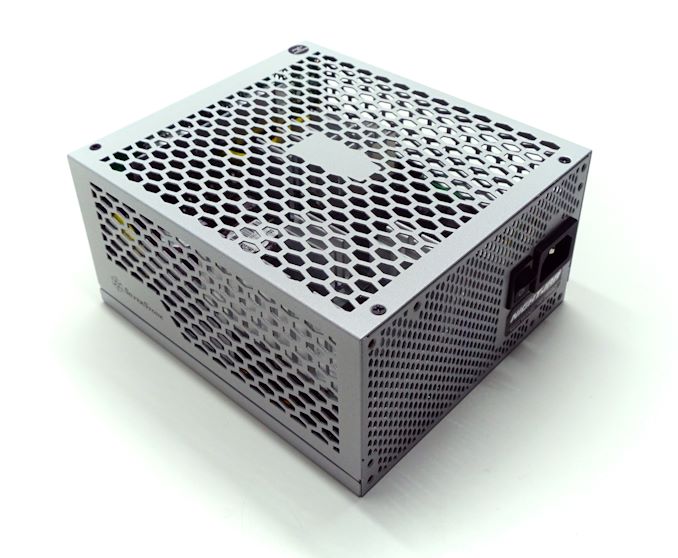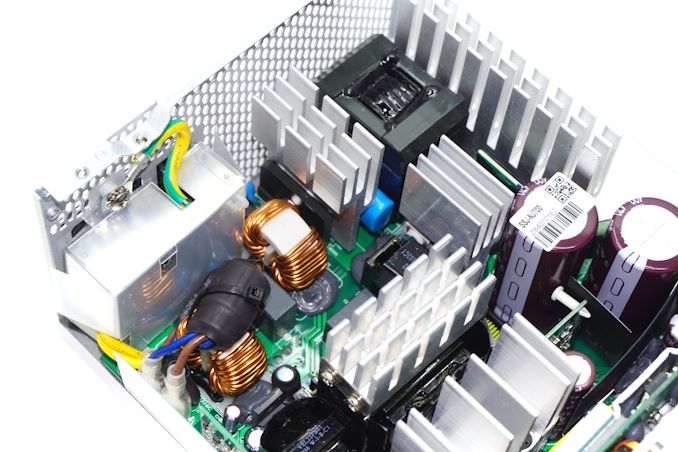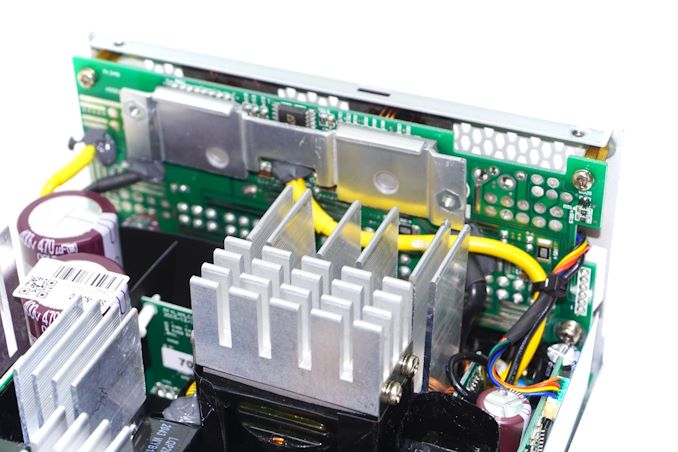The SilverStone NightJar NJ700 Passive PSU Review: Silent Excellence
by E. Fylladitakis on November 29, 2021 8:00 AM EST- Posted in
- Cases/Cooling/PSUs
- PSUs
- SilverStone
- Passive Cooling
Power Supply Quality
As part of our testing, we also check output parameters are within specifications, as well as voltage ripple and line noise.
| Main Output | ||||||||
| Load (Watts) | 141.38 W | 352.97 W | 528.19 W | 703.06 W | ||||
| Load (Percent) | 20.2% | 50.42% | 75.46% | 100.44% | ||||
| Amperes | Volts | Amperes | Volts | Amperes | Volts | Amperes | Volts | |
| 3.3 V | 1.8 | 3.41 | 4.49 | 3.41 | 6.74 | 3.4 | 8.99 | 3.39 |
| 5 V | 1.8 | 5.09 | 4.49 | 5.09 | 6.74 | 5.08 | 8.99 | 5.07 |
| 12 V | 10.42 | 12.1 | 26.06 | 12.08 | 39.09 | 12.05 | 52.12 | 12.03 |
| Line | Regulation (20% to 100% load) |
Voltage Ripple (mV) | |||||
| 20% Load | 50% Load | 75% Load | 100% Load | CL1 12V |
CL2 3.3V + 5V |
||
| 3.3V | 0.75% | 12 | 12 | 14 | 16 | 14 | 12 |
| 5V | 0.5% | 8 | 8 | 10 | 16 | 8 | 12 |
| 12V | 0.6% | 6 | 8 | 8 | 12 | 8 | 12 |
The power quality figures that we received while testing the SilverStone NJ700 inside our hotbox were astounding. We recorded a maximum voltage ripple of 12 mV on the 12V line at 100% load, an incredible power quality figure by any comparison. Voltage regulation also is very tight on the 12V line, staying lower than 0.6% across the nominal output range. The secondary 3.3V and 5V rails are a bit less well filtered, with the voltage ripple reaching 16 mV on both rails under maximum load. Otherwise, the secondary lines are just as tightly regulated, at around 0.5% for both the 3.3V and 5V rails.
Conclusion
SilverStone is greatly focused on the development of high-performance living room entertainment PCs, which goes in tandem with the marketing of ultra-quiet PSUs. The Nightjar NJ700 is a statement product designed both to lure in enthusiasts that will not mind the hefty price tag and to outdo the company’s main competitors.
The OEM behind the Nightjar NJ700 is SeaSonic, perhaps the most reputable top-tier PC PSU OEM. On top of that, the NJ700 is based on what is currently SeaSonic’s best platform. We found only top-tier components inside the Nightjar NJ700, ranging from critical parts down to insignificant filtering capacitors. The developer of this PSU spared no expense and that showed during our testing, when the Nightjar NJ700, a PSU that lacks any form of active cooling, was operating unaffected inside our hotbox and with virtually no change in its performance. SilverStone covers the Nightjar NJ700 with a five-year warranty, which is sufficient, yet strange when the OEM markets the same platform with a 12-year warranty.
Although the platform that the Nightjar NJ700 is analog and relatively basic by today’s standards, the designer of this PSU managed to get ridiculous performance figures out of it. The Nightjar NJ700 comes with an 80Plus Titanium certification tag and it honors it, delivering exceptionally high energy conversion efficiency even when the load is very low. Efficiency is not the only thing that the NJ700 excels on, as its power quality figures also are astounding. Despite its lack of active cooling, heat has practically no effect on the unit’s electrical performance either. All in all, the overall performance of the Nightjar NJ700 is world-class.
With all of that said, when using a passively cooled PSU, there are certain implications that need to be considered. The major point that is the fact that the thermal losses of the PSU will be released inside the system itself, whereas typical, active-cooled PSUs would exhaust most of that thermal energy to the outside of the case. This means that the system itself will get hotter and may require better cooling in order to sustain its overall performance. In this case, the high power output of the NJ700 translates to significant thermal losses when the unit is heavily loaded – regardless of its very high efficiency, there will be more than 35 Watts of thermal energy released to the environment. This will probably not be a problem with modern systems that are built with efficiency in mind, but the specifics of this must be considered and weighted by the system’s builder. After all, it would not make any sense to use a passively cooled PSU only to replace it by another noise source, such as additional case fans.
SilverStone’s choice to market the Nightjar NJ700 could not have been easy. On one hand, the nature of the product aligns with the company profile and their efforts to develop top-performance living room gaming systems. On the other hand, SilverStone has to compete with the OEM of the NJ700, the legendary SeaSonic, as they also market the same platform under their own brand. Practically no other company offers direct competition to the passively cooled NJ700 right now, meaning that its success largely depends on how well its $308 retail price and overall availability fare in comparison to SeaSonic’s Prime Fanless TX-700. That, in conjunction with the strangely significantly shorter warranty length, can be a very complicated subject for SilverStone’s marketing department.













46 Comments
View All Comments
Rοb - Tuesday, November 30, 2021 - link
The only reason I see is that it's silver colored and says SilverStone on it, which might fit better with a SilverStone case build.SeaSonic's closest choices are black and white: https://seasonic.com/prime-fanless-tx or https://seasonic.com/prime-snow-silent
The choice seems fairly black and white to me too, unless you want SeaSonic's black and red 850W model; with advanced fan control - no harm in having a slow fan in the power supply to create a draft in a clearly useful direction, rather than relying on faster case fan speeds to guarantee that the flow through the power supply is above the minimum requirements.
tonyou - Monday, January 3, 2022 - link
Looks like the tuning we did to improve standby efficiency and reduced electrical noise/whine helped to make it perform a little better overall according to latest test result by TechPowerUp:https://www.techpowerup.com/review/seasonic-prime-...
Somewhat surprised Seasonic didn't bother to implement the changes made to our Nightjar NJ700 into their own retail version.
Arbie - Monday, November 29, 2021 - link
Quieter is better, and a passive design admirable - but the PSU adds little to the overall noise of my system. The fact that it can even be managed passively should tell you something. Case fans and CPU / GPU cooling contribute much more and I think always will.Oxford Guy - Monday, November 29, 2021 - link
‘the PSU adds little to the overall noise of my system’That’s one data point and we don’t know about all the variables. Your system could use Delta industrial fans at full tilt to cool its components or a recent Atom motherboard.
CharonPDX - Monday, November 29, 2021 - link
Impressive. I have a media center computer that has plenty of airflow around it that I'm trying to quiet down. It uses ~250-300W at "full power", I've always been using a 350-450W PSU in it, but this thing being most efficient at right around that power range seems very tempting.Oxford Guy - Monday, November 29, 2021 - link
‘This typically is not a concern for gamers, as the noise generated by the PC is often overshadowed by the speakers or headphones.’Strongly disagree.
I’ve read this headphones claim many times but even the kind of noise-blockers sold in hardware stores let some noise through.
A game that is designed to use subtle environmental sounds to create ambiance is generally going to be undermined by fan noise, especially if it uses PWM.
Trying to bury noise with speakers makes even less sense.
One of the things I especially disliked about the CD-ROM era of consoles was all the noise the machine outputted. As someone who started with fanless cartridge-based gaming the idea of it not being important to have a quiet unit — even with bleep/bloop arcade stuff, is one experience doesn’t support.
Young people are getting hearing damage from using headphones in noisy environments. Blasting music can mask noise but there’s a price to pay.
Wrs - Tuesday, November 30, 2021 - link
Active noise cancelation fixes this, though there are times when being environmentally unaware is a liability.Practically, I just find it quite hard to build a 700w system under 25db. Even water pumps and most radiator fans break that if loaded. Most those top PSUs with fans sit around low 20s dB at full load, and the noise is low frequency so very easy for ANC to deal with.
Oxford Guy - Thursday, December 2, 2021 - link
Citation please for the noise cancellation claim. If that’s true then the LRAD can be easily defeated by people wearing noise-cancelling headphones.I also think the claim that the total system noise is determined solely by whatever component produces the most noise is false. One 25 decibel fan is quiet. Five of them is louder. So, PSU noise can add to the sum.
Wrs - Saturday, December 4, 2021 - link
Which claim? The low frequency knack is common knowledge and I figure anyone who's tried ANC would discover it. Wiki ANC and search for "active vs. passive."I use ANC and barely hear the drone of 1500 rpm fans when my fully air cooled open case rig is loaded to >700 watts at the wall. Forget about hearing anything <1000 rpm with the -30 dB attenuation typical of low frequency ANC.
We're talking quiet office level sound of course. Idk if ANC can even be designed against an LRAD, where it's not even so much hearing damage as tissue injury from shock and cavitation.
Oxford Guy - Friday, December 10, 2021 - link
If noise cancellation is as good as you claim then it’s going to save a lot of people’s hearing. A recent journal article I read about subway commuters developing hearing loss from too much ambient noise didn’t mention such headphones. Curious that the pro researchers would miss something if it’s that effective. The only time I’ve seem headphone use discussed in an ambient noise hearing loss context is in terms of headphones making the problem worse via people simply turning up the volume.The pair of ‘noise-blocking’ headphones I tried had terrible hiss. PC Mag claims that that’s only seen in low-quality models but those were expensive Beats.
As someone who gets serious tinnitus flareups from computer fans (and possibly coil whine) I am certainly hopeful that this tech is the panacea you say it is.